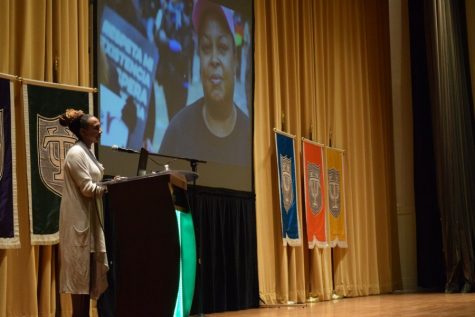Student Organization Spotlight: Finding Intersectionality Together

Anh Nguyen | Associate Artist
Finding Intersectionality Together, also known as FIT, is a student organization dedicated to helping students find ways to engage with their own intersectionality.
“Intersectionality” refers to the various categories, such as biological, social and cultural, that overlap with one another to contribute to discrimination and social inequality. The word was originally coined by civil rights advocate and law scholar Kimberlé Crenshaw in 1989 to help explain the oppression of black women, specifically in the workplace.

Kimberlé Crenshaw, who coined the phrase, “intersectionality,” visited Tulane on Sept. 25.
With a newly motivated leadership and general body, FIT is currently looking to reestablish its presence on campus as a club that caters to students seeking a place to voice their thoughts and opinions on intersectionality and its pertinence to student life.
Sophomore and FIT president Alexis Martin believes such discourse is crucial to our campus.
“Currently [the Tulane community is] not being very intentional about engaging with certain conversations,” Martin said. “Whether it’s about race and how that intersects with the student experience here or around gender and sexuality and how that intersects with sexual violence on this campus.”
FIT, however, aims to reverse that trend and create an environment in which students can come together to discuss intersectionality. In this environment, students are encouraged to have what many students see as difficult but necessary conversations.

Finding Intersectionality Together club returns to campus.
In previous years, FIT has been on hiatus, but the club returned during this academic year.
The new iteration of FIT is trying to be realistic as it revives its campus presence. Martin admitted that due to the tendency for high levels of involvement among Tulane students, it is often hard to tie them down for things such as regular general body meetings. FIT’s leadership team has decided to cater to this tendency.
“I wanted FIT to operate as a space for people very involved in other organizations to be able to come in and talk about what they would like to see their organizations push for in terms of achieving more intersectional programming,” Martin said.
FIT aims to facilitate connections between other organizations, especially other multicultural organizations.
FIT recognizes that though there is an abundance of great organizations on campus, there is a lack of communication and collaboration among them. By creating a space for organizations to work together, FIT hopes to bring more pertinent and meaningful programs on campus.
Above all, FIT desires to create a space in which people feel welcome and able to be vulnerable.
“As in the name of our club, we are finding intersectionality together. This is a process that has to be done together,” Martin said.
Your donation will support the student journalists of Tulane University. Your contribution will allow us to purchase equipment and cover our annual website hosting costs.
















Leave a Comment